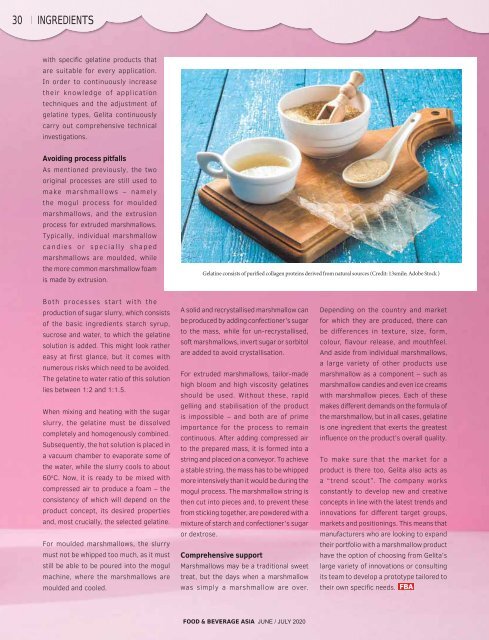Food & Beverage Asia June/July 2020
Food & Beverage Asia (FBA) is the leading source of food and beverage news in Asia since 2002. FBA delivers a comprehensive view of the food and beverage landscape, spanning across the latest health and nutrition trends and industry innovations in ingredients, recipe formulations, food science, sustainability, packaging, and automation, as well as advancements in agri and food-tech.
Food & Beverage Asia (FBA) is the leading source of food and beverage news in Asia since 2002. FBA delivers a comprehensive view of the food and beverage landscape, spanning across the latest health and nutrition trends and industry innovations in ingredients, recipe formulations, food science, sustainability, packaging, and automation, as well as advancements in agri and food-tech.
Create successful ePaper yourself
Turn your PDF publications into a flip-book with our unique Google optimized e-Paper software.
30<br />
INGREDIENTS<br />
with specific gelatine products that<br />
are suitable for every application.<br />
In order to continuously increase<br />
their knowledge of application<br />
techniques and the adjustment of<br />
gelatine types, Gelita continuously<br />
carry out comprehensive technical<br />
investigations.<br />
Avoiding process pitfalls<br />
As mentioned previously, the two<br />
original processes are still used to<br />
make marshmallows – namely<br />
the mogul process for moulded<br />
marshmallows, and the extrusion<br />
process for extruded marshmallows.<br />
Typically, individual marshmallow<br />
candies or specially shaped<br />
marshmallows are moulded, while<br />
the more common marshmallow foam<br />
is made by extrusion.<br />
Gelatine consists of purified collagen proteins derived from natural sources (Credit: 13smile; Adobe Stock )<br />
Both processes start with the<br />
production of sugar slurry, which consists<br />
of the basic ingredients starch syrup,<br />
sucrose and water, to which the gelatine<br />
solution is added. This might look rather<br />
easy at first glance, but it comes with<br />
numerous risks which need to be avoided.<br />
The gelatine to water ratio of this solution<br />
lies between 1:2 and 1:1.5.<br />
When mixing and heating with the sugar<br />
slurry, the gelatine must be dissolved<br />
completely and homogenously combined.<br />
Subsequently, the hot solution is placed in<br />
a vacuum chamber to evaporate some of<br />
the water, while the slurry cools to about<br />
60 o C. Now, it is ready to be mixed with<br />
compressed air to produce a foam – the<br />
consistency of which will depend on the<br />
product concept, its desired properties<br />
and, most crucially, the selected gelatine.<br />
For moulded marshmallows, the slurry<br />
must not be whipped too much, as it must<br />
still be able to be poured into the mogul<br />
machine, where the marshmallows are<br />
moulded and cooled.<br />
A solid and recrystallised marshmallow can<br />
be produced by adding confectioner’s sugar<br />
to the mass, while for un-recrystallised,<br />
soft marshmallows, invert sugar or sorbitol<br />
are added to avoid crystallisation.<br />
For extruded marshmallows, tailor-made<br />
high bloom and high viscosity gelatines<br />
should be used. Without these, rapid<br />
gelling and stabilisation of the product<br />
is impossible – and both are of prime<br />
importance for the process to remain<br />
continuous. After adding compressed air<br />
to the prepared mass, it is formed into a<br />
string and placed on a conveyor. To achieve<br />
a stable string, the mass has to be whipped<br />
more intensively than it would be during the<br />
mogul process. The marshmallow string is<br />
then cut into pieces and, to prevent these<br />
from sticking together, are powdered with a<br />
mixture of starch and confectioner’s sugar<br />
or dextrose.<br />
Comprehensive support<br />
Marshmallows may be a traditional sweet<br />
treat, but the days when a marshmallow<br />
was simply a marshmallow are over.<br />
Depending on the country and market<br />
for which they are produced, there can<br />
be differences in texture, size, form,<br />
colour, flavour release, and mouthfeel.<br />
And aside from individual marshmallows,<br />
a large variety of other products use<br />
marshmallow as a component – such as<br />
marshmallow candies and even ice creams<br />
with marshmallow pieces. Each of these<br />
makes different demands on the formula of<br />
the marshmallow, but in all cases, gelatine<br />
is one ingredient that exerts the greatest<br />
influence on the product’s overall quality.<br />
To make sure that the market for a<br />
product is there too, Gelita also acts as<br />
a “trend scout”. The company works<br />
constantly to develop new and creative<br />
concepts in line with the latest trends and<br />
innovations for different target groups,<br />
markets and positionings. This means that<br />
manufacturers who are looking to expand<br />
their portfolio with a marshmallow product<br />
have the option of choosing from Gelita’s<br />
large variety of innovations or consulting<br />
its team to develop a prototype tailored to<br />
their own specific needs. FBA<br />
FOOD & BEVERAGE ASIA JUNE / JULY <strong>2020</strong>


















